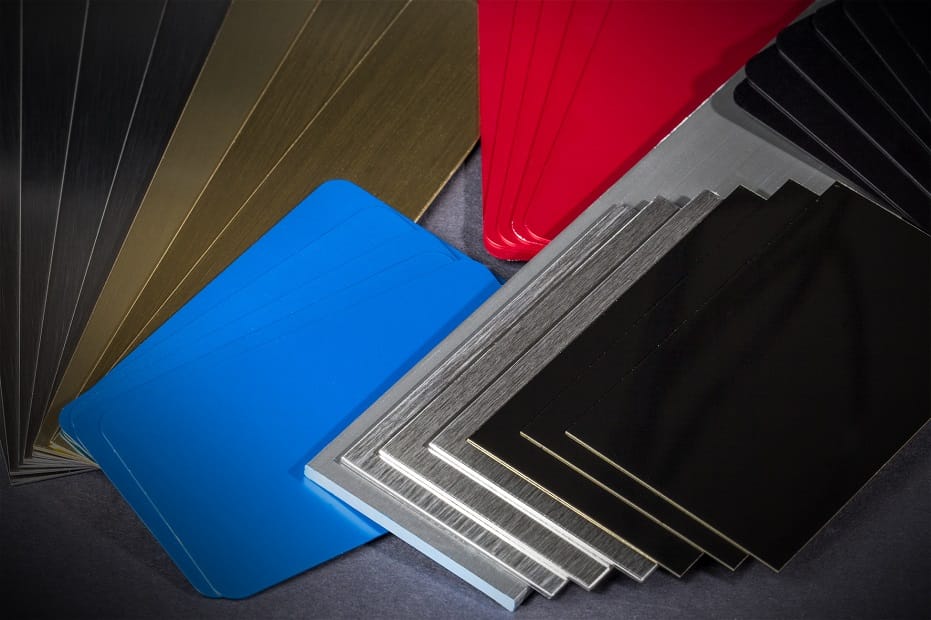Metals
Metals are inorganic materials with high thermal and electrical conductivity. Metals can be rolled to form plates or sheets, or they can be cast or machined to form more complex shapes. Metals can be pure elements such as iron or chrome. Metals can also be alloys, or mixtures of two or more elements. For example, stainless steel contains both iron and chrome. Laser marking is a common application for metals. Laser cutting and engraving are also possible with sufficient laser power. Visit our Materials Suppliers List for metal vendors.
Types of Metal
- Aluminum
- Brass
- Copper
- Hastelloy®
- Inconel
- Iron
- Nickel
- Pewter
- Silver
- Stainless Steel
- Steel
- Titanium
- Zinc
- AlumaMark®
- Anodized Aluminum
- Cermark and Thermark Metal Marking Compound
- DuraBlack®
- Painted Metal
- Powder Coated Metal
Types of Laser Processes
Lasers are playing an ever expanding role in material processing, from new product development to high volume manufacturing. For all laser processes, the energy of a laser beam interacts with a material to transform it in some way. Each transformation (or laser process) is controlled by precisely regulating the wavelength, power, duty cycle and repetition rate of the laser beam. These laser processes include the following:All materials have unique characteristics that dictate how the laser beam interacts and consequently modifies the material. The most common processes for metals are the following:
Laser Cutting of Metals
The energy of a Fiber laser beam is easily absorbed by most metals, causing the material directly in the path of the laser beam to rapidly heat up and melt. If the laser power is sufficiently high, the laser beam will melt completely through the material. A jet of high pressure air is used to remove the metal as it melts, resulting in smooth and straight edges with minimal heat affected zone.
Laser Engraving of Metals
The power of the Fiber laser beam can be limited so that it removes (engraves) material to a specified depth. Several laser engraving passes are usually required. The common depth for metal laser engraving is 0.003 to 0.005” (75 to 125 microns). However removing this much metal in a single pass could cause melting or distortion. Therefore metal engraving is usually done in multiple passes. The laser engraving process can be used to create permanent identification marks that can’t be removed by heat or wear.
Laser Marking of Metals
Laser marking changes the appearance of the metal surface without removing material. There are several different types of laser marking that can be used for metals. Direct laser marking can be done with either a Fiber laser or a CO2 laser. In direct marking, the laser beam energy heats the metal surface causing it to oxidize. This oxidation causes the metal that has been exposed to the laser beam to darken, creating an indelible, black mark. The Fiber laser can also be used to create a bright, or polished, mark on the metal surface. Metal can also be marked indirectly, either by adding a coating such as metal marking compound, or by removing a coating such as paint. Laser marking can be used to convey information such a serial number or a logo.
Combined Processes
The laser cutting, engraving, and marking processes described above can be combined without having to move or re-fixture the metal part.
General Metal Laser System Considerations
Platform Size – Must be large enough to hold the largest pieces of metal that will be laser processed or be equipped with Class 4 capability for processing larger pieces.
Wavelength – The 1.06 micron wavelength is absorbed well by most metals and is recommended for laser cutting, engraving, and direct marking metals. The 10.6 micron wavelength CO2 laser is the best choice for indirect marking process using metal marking compound or coating removal.
Laser Power – Must be selected based on the processes that will be performed. At least 50 watts of Fiber laser power is recommended for metal laser cutting or engraving. Forty or 50 Watts of Fiber laser power can be used for direct laser marking metals. Twenty-five to 150 Watts of CO2 laser power is recommended for direct marking of metals.
Lens – A 2.0 lens is the best general process lens for metal laser material processing.
Exhaust – Must have sufficient flow to remove the gasses and particles that are generated during laser process from the metal laser cutting, engraving, and marking equipment.
Air Assist – Provides a jet of air near the focal point of the laser to remove molten metal during laser cutting and engraving. Also helps remove gasses and particles that are generated during metal laser engraving, cutting. and marking.
Environmental, Health and Safety Considerations for Metal Laser Material Processing
Laser-material interactions almost always create gaseous effluent and/or particles. The effluent will include metal particles for laser metal cutting and engraving. It will include coating components for indirect laser marking. This effluent should be routed to an exterior environment. Alternatively it may be treated with a filtration system first and then routed to an exterior environment. All laser processes generate heat. Therefore metal laser material processing should always be supervised.

